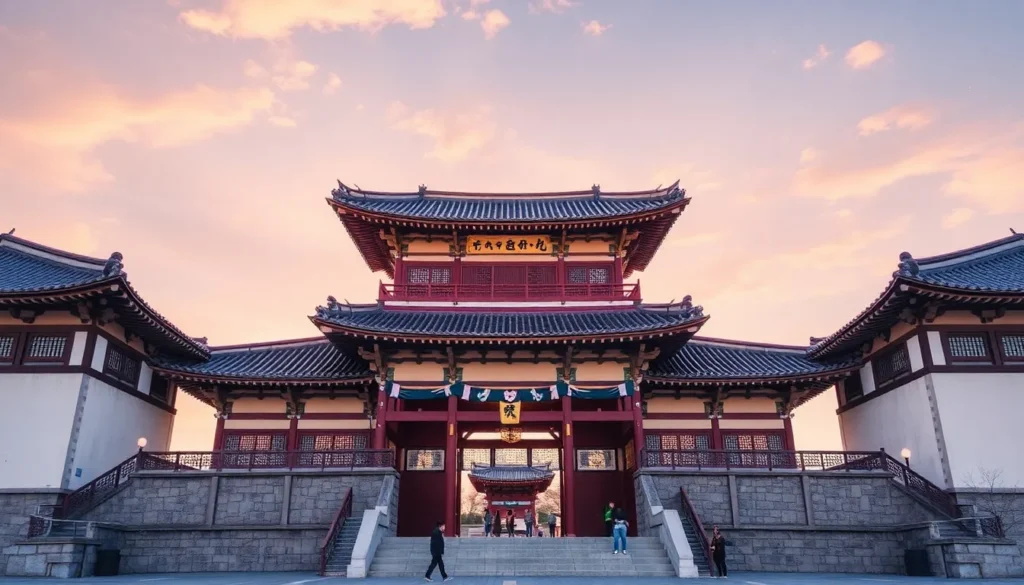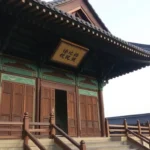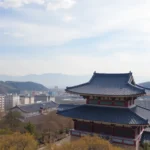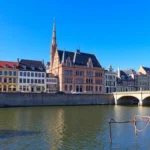10 things to see and do in South Korea

- 1. Exploring Seoul: The Gigantic Capital of South Korea
- 2. Busan: Color and Seafood
- 3. Jeju Island: A Stunning Destination in South Korea
- 4. Gyeongju: The City Where Hills Hide Secrets
- 5. DMZ: The Most Unique Excursion in Korea
- 6. Hwasong Fortress: A Journey Back Two Centuries in One Hour from Seoul
- 7. Seoraksan National Park: A Haven for Nature Lovers
- 8. Jeonju: Tradition and Tourism in Equal Measure
- 9. Haeinsa Temple: A Treasure of Wooden Tablets
- 10. Conclude Your Journey in a Korean Sauna
- 11. Eating: More Than Just a Routine
- More things to see and do in South Korea
There's an old Korean proverb that says, "Go to Korea, come back, and go again." While you may not have heard it before, it certainly holds a wealth of wisdom—Korea is a place that beckons you to return time and again! This small Asian giant teems with unique attractions, rich history, and vibrant culture, making it one of the most captivating destinations on the planet. Would you like to learn about the best things to see and do in South Korea? Buckle up and prepare to uncover one of Asia's best-kept treasures.
South Korea has an intriguing aura; we've all heard of it—be it through its bustling capital, the rise of K-pop, or its renowned skincare products—but few truly understand what this remarkable country has to offer. Yes, Seoul is an electrifying metropolis, the beauty industry is thriving, and groups like Blackpink are topping charts worldwide. However, there's so much more to explore! After nearly a month of traversing the country, we can confidently declare that South Korea is a diamond in the rough, waiting to be fully appreciated.
During our travels, we were pleasantly surprised by the low number of international tourists, even on the most popular routes. We believe that in a few years, South Korea will gain the fame and recognition that Japan currently enjoys, and it certainly deserves it. With incredible sites, a rich culture, and delectable cuisine, South Korea is a traveler's paradise. Are you ready to discover what we consider the best things to see and do in South Korea? Here’s our top 10 list of attractions in South Korea:
1. Exploring Seoul: The Gigantic Capital of South Korea
During my first visit to South Korea, I spent 15 days in Seoul, yet I still left with neighborhoods unexplored, temples unvisited, and streets undiscovered. This time, we made a point to explore the city thoroughly over ten days, and guess what? We still couldn't finish our list of things to see and do!
Seoul is one of the most vibrant, dynamic, and fascinating cities in Asia and also one of the largest! The plans here are nearly endless: from visiting ancient royal palaces that make you feel like you’ve traveled back in time, to wandering through charming neighborhoods filled with traditional houses and futuristic shops. You can catch spontaneous K-pop dance performances on the street and savor local dishes in bustling food markets.
Can you tell we love this city? Our affection for Seoul is eternal!
⭐ For more information, check out our post on 25 things to see and do in Seoul.
2. Busan: Color and Seafood
Busan, the second-largest city in South Korea, is the perfect stop before heading to Jeju Island. While Seoul may top our list, Busan offers its own unique charm. Here, you can visit the country's largest fish market and indulge in fresh seafood delights, enjoy a relaxing day at one of its popular beaches (which get quite crowded in summer), or explore one of the few seaside Buddhist temples.
Don't miss the chance to stroll through the Gamcheon Cultural Village, an old neighborhood of narrow, steep alleyways revitalized by an artistic project filled with murals and street art. Busan is bustling, colorful, and fun—though it may never quite compare to Seoul.
⭐ For more activities, check out our post on things to do in Busan.
3. Jeju Island: A Stunning Destination in South Korea
Alongside Seoul, Jeju was a must-visit on our itinerary. This island, located south of the mainland, is a favored getaway for Koreans, often described as the "Hawaii of Korea." Initially, this comparison seemed a stretch, but we found it quite fitting.
Jeju showcases a wild and natural beauty, boasting lush forests, breathtaking waterfalls (one cascades directly into the sea), tea fields, volcanoes, scenic trails, and stunning beaches. In contrast to its pristine side, the island also has a more developed, tourist-friendly vibe.
Jeju's unique culture, including the iconic "grandmother statues" that protect homes and the haenyeo—the "mermaid grandmothers" who risk their lives diving for seafood and have gained recognition as a UNESCO cultural heritage—will surely enchant you.
⭐ Stay tuned for our upcoming post with tips for visiting Jeju Island, where we’ll delve into the best things to do in Korea.
4. Gyeongju: The City Where Hills Hide Secrets
At first glance, Gyeongju appears to be a small and charming city with rolling green hills. However, this city was once the capital of the historical Silla dynasty, which ruled for a millennium. Those seemingly innocuous hills are actually royal tombs!
Gyeongju surprised us during our trip, making it a must-see, especially if you are drawn to cultural and historical sites. The city is home to numerous museums showcasing valuable artifacts from the past (the crowns are particularly impressive!), and you may find yourself intrigued by what lies within those ancient burial mounds.
Additionally, Gyeongju offers other attractions, including beautiful bridges and a traditional hanok village that has turned into charming cafes (one of which is among the most beautiful Starbucks in the world) and restaurants.
Don't miss the chance to visit the Bulguksa Temple, one of the most significant temples in the country, just 30 minutes away by bus, and the revered Seokguram Grotto, which houses a stunning stone-carved Buddha.
⭐ For more insights, check out our post on things to do in Gyeongju.
5. DMZ: The Most Unique Excursion in Korea
A visit to the Demilitarized Zone (DMZ), which separates North and South Korea, promises to be one of the most fascinating and surreal experiences of your trip. Following the Cold War, the Korean Peninsula was divided, leading to the formation of two countries that have taken vastly different paths since then. While there's much to say about the northern neighbors, it's best to explore this intriguing history.
The DMZ is laden with emotional weight, given that thousands of families were separated and never reunited. Although the tour felt somewhat touristy, where else will you get the chance to "spy" on the North Korean people going about their daily lives through binoculars? You'll also venture into one of the four tunnels excavated for clandestine crossings into the South.
If you're passionate about Korean history and want to delve deeper into the events that shaped this part of the world after World War II, be sure to book a spot on this DMZ tour from Seoul (it takes about half a day).
⭐ For more details, check out our guide on visiting the DMZ.
6. Hwasong Fortress: A Journey Back Two Centuries in One Hour from Seoul
A highly recommended day trip from Seoul is to Hwasong Fortress, built in the 18th century by the powerful Joseon dynasty. It's known as one of the most impressive and well-preserved fortresses in the country.
Located in Suwon, about an hour south of Seoul, the fortress features imposing gates at each cardinal point, a 5 km long wall that you can walk along, and several military structures that history enthusiasts will adore. It’s no wonder that it’s one of Korea’s most popular monuments and a UNESCO World Heritage site.
7. Seoraksan National Park: A Haven for Nature Lovers
One thing that stood out during our time in Korea is how much the locals cherish their time in nature. Seoraksan National Park is undoubtedly one of their favorite spots. With its cinematic landscapes, rocky terrains, cascading waterfalls, and lush green forests, it provides an ideal setting for relaxation and recharging amidst nature (though you may end up with some sore muscles!).
Located in the northeast of the country, about three hours from Seoul, the best way to visit is by renting a car. Alternatively, you can reach Sokcho and take a bus to the park entrance. This was one of the experiences we managed to partake in during our trip, and it’s definitely on our list for a return visit.
For a more accessible option, consider Bukhansan National Park, right next to Seoul, offering numerous trails that cater to different fitness levels and time constraints.
8. Jeonju: Tradition and Tourism in Equal Measure
Jeonju, the birthplace of the Joseon dynasty, boasts the largest and best-preserved Hanok village in South Korea. Hanoks are traditional houses made of wood and clay, featuring distinctive green, brown, or blue tiled roofs. While you can find several historic neighborhoods in Seoul, Jeonju’s Hanok village is worth the detour, even if just for an overnight stay.
Many Korean families flock here on weekends, dressed in traditional attire, filling the charming streets. Jeonju is also known as the capital of bibimbap, one of the most beloved Korean dishes (though we personally enjoyed the grilled octopus skewers even more).
⭐ For more things to see in Jeonju, check out our post on Jeonju.
9. Haeinsa Temple: A Treasure of Wooden Tablets
Did you know that in Korea, you can experience life as a monk for a day? There’s a program for both local and international tourists called TempleStay, allowing you to spend a day (or more) in a chosen Buddhist temple (overnight included). We seized the opportunity to participate, and after thorough consideration, we chose to stay at Haeinsa Temple.
Not only will you gain deeper insights into Buddhist rituals and monastic life, but this temple is also a true gem. It houses the famous Tripitaka Koreana, the most complete collection of Buddhist texts, engraved between 1237 and 1249 on more than 80,000 wooden tablets. Nestled within the picturesque Gayasan National Park, it provides an ideal setting for disconnecting from the modern world and reconnecting with nature and spirituality.
⭐ Check out our experience at Haeinsa Temple.
10. Conclude Your Journey in a Korean Sauna
The perfect finale to your South Korean adventure is spending a few hours (or even an entire day) in a traditional sauna. This experience transcends a mere steam bath or exfoliating massage; visiting a Korean sauna is akin to a mega-stress reliever, though you must leave your modesty at the door!
These communal baths have been a fixture in Korea for centuries, and you can find them in almost every city or neighborhood. Inside, you’ll discover saunas and pools at various temperatures, hot and cold rooms, restaurants, and even shared sleeping quarters and TV lounges. There’s no chance of boredom!
⭐ For tips on visiting a Korean sauna (and avoiding common pitfalls), check out our guide.
Also, remember to grab your Revolut card (with a special promo) to avoid fees when paying and withdrawing money abroad.
11. Eating: More Than Just a Routine
Eating in South Korea is a far cry from merely fulfilling a basic need. Dining is a celebration, a joyous occasion that tantalizes all the senses. Few countries emphasize food as much as Korea does. While kimchi is ubiquitous, if you dislike it as much as I do, worry not; it’s typically served as a side, not the main attraction!
Some dishes you must try during your journey include bulgogi (marinated, grilled beef strips), the aforementioned bibimbap (rice with vegetables, meat, and a raw egg), Korean barbecue (an experience in itself!), and fried chicken (yes, Koreans are crazy about fried chicken, especially when paired with soju and/or beer). And don’t forget to explore as many food markets as possible!
⭐ Discover more about Korean culinary delights.
More things to see and do in South Korea
There are undoubtedly many more attractions to discover in South Korea. You could spend a day in Daegu, the Catholic capital of the country (so named for its many churches), explore the Boseong tea fields, trek through Sobaeksan National Park and its temples, delve into the Hwanseongul Cave, or navigate to the nature reserve on Hongdo Island. And we’re sure we’ve left out plenty of places and activities! But for a first trip to Korea, we believe we’ve given you quite the overview of the best things to do in Korea.
What do you think? Does this Asian destination pique your interest? Are there more things you’d like to see and do in South Korea?
Follow our day-to-day adventures in South Korea on our Instagram stories.
| Save on your trip |
| Compare and find cheap flights here. |
| Find accommodation at the best prices here. |
| Book activities and excursions in Spanish here. |
| Get a 5% discount on your IATI travel insurance here |
| Book airport transfers here. |
| Learn how to withdraw money without fees here. |
| Rent a car with the best deals here. |
| Check out the best books and travel guides here. |
| Explore all our articles about South Korea. |




Deja una respuesta